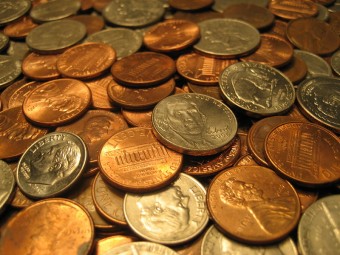Why Some Coins in the United States Have Ridges
 Today I found out why some coins in the United States have ridges.
Today I found out why some coins in the United States have ridges.
Putting ridges on some coins in America got its start back in the 1700’s. At this time, coins were actually made of materials that were worth what the coin was worth. For example, a half dollar silver coin contained fifty cents worth of silver. Likewise, a $10 gold coin contained $10 worth of gold.
As a consequence of this, people started to shave off bits of these coins around the edges; so now a $10 gold piece only contained, say, $9.50 worth of gold. The payoff came from that if they were very careful when they shaved the coins, it was very difficult to tell that anything had been shaved off, so they could still generally get their $10 worth out of the now $9.50 piece. Over time, they’d collect the shavings and when they had a large enough amount, go sell them.
Eventually, the government decided to do something about this and one of the methods to combat this practice was to add ridges to these coins; something known as “Reeding” the coins. With the ridges on the edges, it became significantly more difficult to shave anything off the coins without detection. They chose not to do so with smaller valued coins that came out later, pennies and nickels, because the metals these coins were made of weren’t valuable enough for shaving them to be worth the effort.
So that was then, why do they still do it today when the coins are no longer made of valuable metals? Initially, supposedly it was because it was easier and cheaper than modifying the existing machinery. Today however, it is to help the visually impaired to more easily distinguish between coins of a somewhat similar size like a penny and a dime. This is something unfortunately not done with today’s American paper money, which is indistinguishable to blind people without resorting to tricks like folding them certain ways for different bills, Braille money stampers, or much more recently special apps which will identify the bills for them. Excepting via an app, the blind still need someone to tell them what the bill is in the first place when they receive it, so they can do whatever they do to it to be able to distinguish it later on their own. Although, supposedly the government is working on this problem with one of the most popular suggested solutions being to adopt the new Canadian system of imprinting the bills with Braille.
If you liked this article, you might also enjoy our new popular podcast, The BrainFood Show (iTunes, Spotify, Google Play Music, Feed), as well as:
- What E Pluribus Unum Means
- It Costs More Than Double What Pennies and Nickels are Worth to Produce Them
- How the Blind Dream
- Why We Throw Coins Into Fountains
- Who Invented Braille?
| Share the Knowledge! |
|





*nickels*
*pennies and nickels* These recent articles are really good though. Sort of like a “Best of:” of TIFO.
In the UK notes are different sizes and colours to make it easier for Blind/visually impaired people to distinguish.
In size order from smallest to largest it goes £5 (blue),£10 (Brown),£20 (Purple) and £50 (Red).
Paper money up here in Canada has braille on it..
Appreciate the blind rights advocacy at the end.
“This is something unfortunately not done with today’s American paper money, which is indistinguishable to blind people” – Not only blind people… Anyone who isn’t American! My vision is fine, but all your money looks the same!
Seriously, what would be the problem with jamming a few holes in a bill? I’m totally fine with it, I’m sure the cost of creating new circulating bills with blind-aid brail punching could not cost that much.
The practice of shaving off coin metal is known as “stemming”. Would have made and interesting fact in an article about stemming gold.